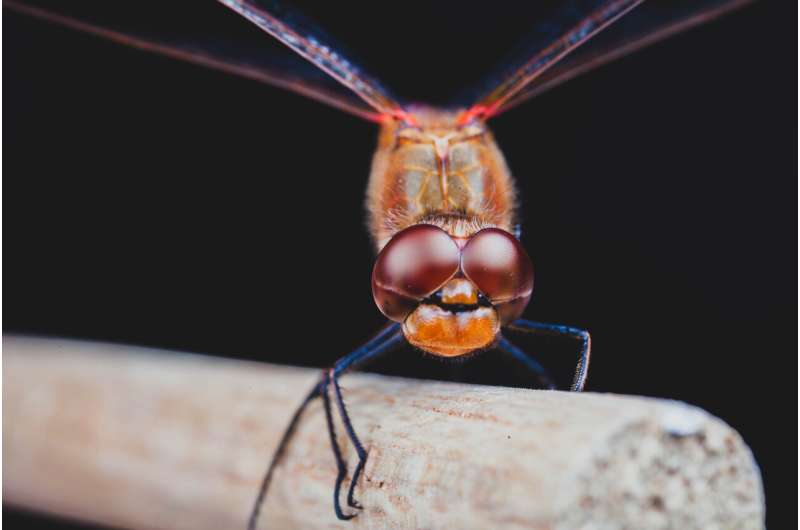Dragonflies perform upside down backflips to right themselves

The findings add to current knowledge of how insects fly and keep stable in the air. They could also help to inspire new designs in small aerial vehicles like drones, which can be useful for search-and-rescue attempts and building inspection.
Our colourful sunny-day companions can glide, fly backwards, and travel up to 54 km/h when hunting prey or escaping predators—but like any flying creature, they can be thrown off balance and even find themselves upside down.
Many land-based animals like cats, and aerial animals like hoverflies, rotate themselves around a head-to-tail axis when falling, known as 'rolling', but not much is known about how most insects right themselves from extreme orientations.
In a new study published today in Proceedings of the Royal Society B, Imperial College London researchers have found that unlike many animals documented to date, dragonflies most frequently perform upside down backflips, known as 'pitching', to right themselves from upside down positions in the air.
They also found that dragonflies perform the same righting maneuver whilst unconscious, suggesting the response has a large component of passive stability—a flight mechanism like that which lets planes glide when their engines are switched off. The research reveals how the shape and joint stiffness of the dragonflies' wings provide passive stability and could inform designs for small drones.
Senior author Dr. Huai-Ti Lin, of Imperial's Department of Bioengineering, said: "Engineers could take inspiration from flying animals to improve aerial systems. Drones tend to rely heavily on fast feedback to keep them upright and on course, but our findings could help engineers incorporate passive stability mechanisms into their wing structure."
To conduct the study, the researchers dressed 20 common darter dragonflies with tiny magnets and motion tracking dots like those used to create CGI imagery.
They then magnetically attached each dragonfly to a magnetic platform either rightside-up or upside-down with some variations in tilt, before releasing the insects into a freefall. The motion tracking dots provided moving 3-D models of the dragonfly movements, which were captured by high-speed cameras for 3-D reconstruction.
They found that conscious dragonflies, when dropped from the upside-down position, somersaulted backwards to regain the rightside-up position. Dragonflies that were unconscious also completed the somersault, but more slowly.
Dead dragonflies did not perform the maneuver at all, but when their wings were posed into specific live or unconscious positions by researchers, they were able to complete the righting maneuver—albeit with a little more spin around the vertical axis than in live dragonflies. The researchers say this suggests that the maneuver relies on both muscle tone and wing posture, which is inbuilt in the dragonfly as a passive response rather than an active control.
Lead author Dr. Sam Fabian, also of the Department of Bioengineering, said: "Planes are often designed so that if their engines fail, they will glide along stably rather than drop out of the sky. We saw a similar response in dragonflies, despite the lack of active flapping, meaning that some insects, despite their small size, can leverage passive stability without active control.
"Passive stability lowers the effort requirements of flight, and this trait likely influenced how dragonfly shapes evolved. Dragonflies that use passive stability in flight are likely to have an advantage, as they use less energy and are better able to recover from inconvenient events."
The researchers continue to research dragonfly flight biomechanics and will next investigate how these passive effects impact a dragonfly's active vision and guidance strategies in prey interception and obstacle avoidance.
More information: DragonDrop: A novel passive mechanism for aerial righting in the dragonfly, Proceedings of the Royal Society B, rspb.royalsocietypublishing.or … .1098/rspb.2020.2676
Journal information: Proceedings of the Royal Society B
Provided by Imperial College London




















